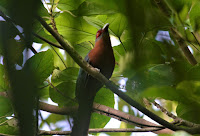It was another thrilling encounter this morning when I stumbled upon the Chestnut-breasted Malkoha ( Phaenicophaeus curvirostris) I could sense its presence about 20 meters away by its peculiar low call when I was approaching Botanic Island One. After a while of looking its whereabout and keeping still beneath the tall trees and dense canopy, my eyes were suddenly attracted to a dark moving figure among the leaves and branches. My patience was rewarded when the Malkoha came out more in the open. Here are a few shots on this morning encounter.
 |
| Chestnut-breasted Malkoha ( Phaenicophaeus curvirostris) |
























